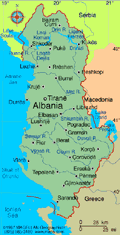Albania
Facts & Figures

-
President: Ilir Meta (2017)
Prime Minister: Edi Rama (2013)
Land area: 10,579 sq mi (27,400 sq km); total area: 11,100 sq mi (28,748 sq km)
Population (2022 est.): 3,095,344 (growth rate: 0.22%); birth rate: 12.69/1000; infant mortality rate: 10.82/1000; life expectancy: 79.47
Capital and largest city (2022 est.): Tirana, 512,000
Other large cities: Durres, 28,9628; Elbasan, 266,245 (2018 est.)
Monetary unit: Lek
National name: Republika e Shqiperise
Languages: Albanian 98.8% (official - derived from Tosk dialect), Greek 0.5%, other 0.6% (including Macedonian, Roma, Vlach, Turkish, Italian, and Serbo-Croatian), unspecified 0.1% (2011 est.)
Ethnicity/race: Albanian 82.6%, Greek 0.9%, other 1% (including Vlach, Roma (Gypsy), Macedonian, Montenegrin, and Egyptian), unspecified 15.5% (2011 est.)
Religions: Muslim 56.7%, Roman Catholic 10%, Orthodox 6.8%, atheist 2.5%, Bektashi (a Sufi order) 2.1%, other 5.7%, unspecified 16.2% (2011 est.)
National Holiday: Independence Day, November 28
Literacy rate: 98.1% (2018 est.)
Economic summary: GDP/PPP (2020 est.): $37.73 billion; per capita $13,300. Real growth rate: 2.24% (2020 est.). Inflation: 1.4% (2019 est.). Unemployment: 5.83% official rate (2019 est.). Note: These are official rates that may not include those working at near-subsistence farming. Arable land: 22.3% (2018). Agriculture: wheat, corn, potatoes, vegetables, fruits, sugar beets, grapes; meat, dairy products. Labor force: 1.104 million; agriculture 41.4%, industry 18.3%, services 40.3% (2018 est.). Industries: food processing, textiles and clothing; lumber, oil, cement, chemicals, mining, basic metals, hydropower. Natural resources: petroleum, natural gas, coal, bauxite, chromite, copper, iron ore, nickel, salt, timber, hydropower. Exports: $3.47 billion (2020 est.): textiles and footwear; asphalt, metals and metallic ores, crude oil; vegetables, fruits, tobacco. Imports: $5.67 billion (2020 est.): machinery and equipment, foodstuffs, textiles, chemicals. Major trading partners: Italy, Spain, Greece, Turkey, Germany, China, France.
Communications: Telephones: main lines in use: 223,469 (2020); mobile cellular: 2,618,880 (2020). Radio broadcast stations: 2 public, 78 private (2019). Television broadcast stations: 3 public, 60+ private (2020). Internet hosts: 508,937 (2020). Internet users: 2,043,251 (2020).
Transportation: Railways: total: 677 km (2020). Highways: total: 18,000 km; paved: 7,020 km; unpaved: 10,980 km (2011). Waterways: 41 km (2011). Ports and harbors: Durres, Sarande, Shengjin, Vlore. Airports: 3 (2021).
International disputes: The Albanian Government calls for the protection of the rights of ethnic Albanians in neighboring countries, and the peaceful resolution of interethnic disputes; some ethnic Albanian groups in neighboring countries advocate for a "greater Albania," but the idea has little appeal among Albanian nationals; the mass emigration of unemployed Albanians remains a problem for developed countries, chiefly Greece and Italy

